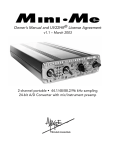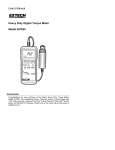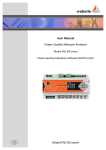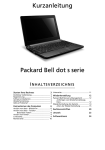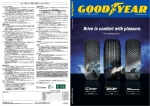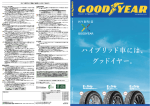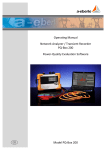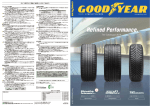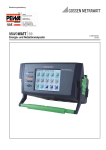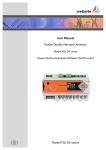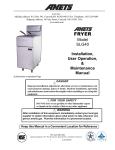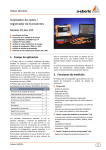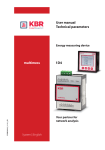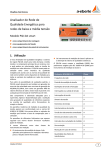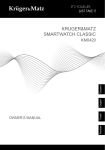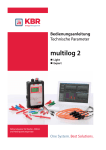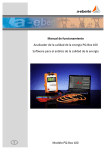Download User manual
Transcript
User manual Technical parameters multilog 2 Light Expert Network analyzer for low, medium and high voltage networks 2 EDEBDA00140-2115-1_EN_multilog 2 i Note Please note that this manual cannot represent the most current device version in all cases. For example, if you replace the device firmware with a newer firmware version downloaded from the internet, the description in this manual may differ from your version. If this is the case, please either contact us directly or refer to the most current version of the manual available for download on our homepage (www.kbr.de). EDEBDA00140-2115-1_EN_multilog 2 KBR Kompensationsanlagenbau GmbH Am Kiefernschlag 7 91126 Schwabach, Germany Phone: +49 (0)9122 6373-0 Fax: +49 (0)9122 6373-83 E-mail: [email protected] Internet: www.kbr.de KBR Kompensationsanlagenbau GmbH does not accept any liability for any loss or damage resulting from printing errors in or changes to this manual. In addition, KBR Kompensationsanlagenbau GmbH does not accept any liability for any loss or damage caused by defective devices or devices manipulated by the user. © KBR GmbH Subject to technical changes 3 1. 1.1 1.2 1.3 User guidance.................................................................................................................................................... 6 Warnings ............................................................................................................................................................. 6 Notes..................................................................................................................................................................... 6 Additional symbols .......................................................................................................................................... 6 2. 2.1 2.2 Scope of delivery/order details ................................................................................................................... 7 Scope of delivery .............................................................................................................................................. 7 Order details....................................................................................................................................................... 7 3. 4. 4.1 4.2 4.2.1 4.2.2 4.2.3 Safety notes ......................................................................................................................................................10 Technical data..................................................................................................................................................11 multilog 2 ..........................................................................................................................................................11 Current clamp accessories ..........................................................................................................................13 Rogowski coils .................................................................................................................................................13 Current clamps ................................................................................................................................................14 Current measurement accessories...........................................................................................................15 5. Intended use ....................................................................................................................................................15 6. Description .......................................................................................................................................................15 7 7.1 7.1.1 7.1.2 7.1.3 7.1.4 7.1.5 7.1.6 7.1.7 7.1.8 7.1.9 7.1.10 7.1.11 7.1.12 Operation ..........................................................................................................................................................16 multilog 2 ..........................................................................................................................................................16 Overview multilog 2......................................................................................................................................16 Direct connection at the 3-phase low voltage network ..................................................................17 Direct connection at the 1-phase low voltage network ..................................................................18 Connection to secondary converters......................................................................................................19 Display ................................................................................................................................................................20 Start measurement ........................................................................................................................................22 Manual trigger.................................................................................................................................................22 Time synchronization via RS232 interface ............................................................................................23 Setup multilog 2 .............................................................................................................................................23 Date, time and language .............................................................................................................................25 Key lock ..............................................................................................................................................................26 Memory management .................................................................................................................................26 8. 8.1 8.2 8.2.1 8.2.2 8.2.3 8.3.4 8.3 8.3.1 8.3.2 8.4 8.4.1 8.4.2 8.4.3 8.4.4 WinPQ mobile evaluation software .........................................................................................................27 Install/uninstall/update software .............................................................................................................27 WinPQ mobile start screen .........................................................................................................................29 General software settings .........................................................................................................................30 Loading the measurement data from the multilog 2 measuring device to the computer .34 Data folder in Windows explorer ............................................................................................................35 Downloading measured data during measurement ......................................................................36 Evaluation of measured data ...................................................................................................................37 Change measured data folder ..................................................................................................................37 Standard analysis according to EN50160 and IEC61000-2-2 ........................................................40 Bar chart of harmonics and interharmonics .........................................................................................45 Current harmonic evaluation in accordance with D-A-CH-CZ ......................................................48 Long-term data level-time charts ...........................................................................................................49 Oscilloscope recordings ..............................................................................................................................56 10 ms RMS disturbance records ...............................................................................................................58 4 EDEBDA00140-2115-1_EN_multilog 2 Table of contents Ripple signal recorder .................................................................................................................................59 PQ events ..........................................................................................................................................................60 Data export interval data ...........................................................................................................................62 Additional functions ....................................................................................................................................65 9. 9.1 9.1.1 9.2 9.3 9.4 9.5 9.6 9.7 Limits and settings of the multilog 2 ......................................................................................................67 Setup – basic settings ...................................................................................................................................68 Measured data size ........................................................................................................................................70 Setup – limits EN50160/IEC61000-2-2/IEC61000-2-4 .......................................................................74 Trigger settings for the oscilloscope image .........................................................................................75 10 ms RMS recorder .....................................................................................................................................77 multilog 2 firmware update ......................................................................................................................78 multilog 2 license update ...........................................................................................................................78 Data converter ................................................................................................................................................79 10. 10.1 10.2 10.3 10.4 10.5 10.6 10.7 10.8 10.9 11 Online analysis: multilog 2 & computer .................................................................................................81 Online oscilloscope image ........................................................................................................................81 Online FFT – 5,000 Hz ...................................................................................................................................82 Online harmonics .........................................................................................................................................84 Online interharmonics .................................................................................................................................85 Online direction of harmonics .................................................................................................................86 Online level-time chart ...............................................................................................................................87 Online details of measured values .........................................................................................................88 Online phasor diagram ................................................................................................................................89 Power triangle ...............................................................................................................................................90 Methods of measurement/formulas of the multilog 2.....................................................................91 12. Maintenance/cleaning .................................................................................................................................99 13. Standards and regulations ..........................................................................................................................99 14. Disposal .............................................................................................................................................................99 15. Product warranty............................................................................................................................................99 EDEBDA00140-2115-1_EN_multilog 2 8.4.5 8.4.6 8.4.7 8.4.8 5 1. User guidance 1.1 Warnings Warning levels Depending on the type of danger, warnings are differentiated by the following signal words: Danger indicates danger to life Warning indicates a risk of injury Caution indicates a risk of property damage Structure of warnings Type and cause of danger Signal word 1.2 Measure to avoid danger. Notes Note on the proper handling of the device 1.3 Additional symbols Instructions for use Structure of instructions: Instructions for an action. Information on the result if required. Lists Structure of unnumbered list: List level 1 - List level 2 EDEBDA00140-2115-1_EN_multilog 2 Structure of numbered list: 1) List level 1 2) List level 1 1. List level 2 2. List level 2 6 2. Scope of delivery/order details 2.1 Scope of delivery multilog 2 User manual Case 3 red dolphin clamps, 1 blue dolphin clamp, 1 green dolphin clamp 3 fuse taps USB cable 2.2 Order details Three measurement functions are available for multilog 2. multilog 2 light - This device version is suitable for performance checks and voltage quality analyses according to EN50160, IEC61000-2-2 or IEC61000-2-4. multilog 2 expert - This device version features extensive trigger options for recording oscilloscope images and 10 ms RMS values. multilog 2 light or expert with Ripple control signal analysis - This device version is suitable for triggering and recording Ripple control signals. EDEBDA00140-2115-1_EN_multilog 2 You can upgrade multilog 2 later on by entering a new license code. 7 EDEBDA00140-2115-1_EN_multilog 2 Features Disturbance recorder and network analyzer in accordance with DIN EN 50160 and IEC 61000-3-40 class A Mobile power quality network analyzer and power meter for low, medium and high voltage networks in accordance with DIN EN-50160/IEC 6100-4-30 class A 2 GB flash memory USB interface Display IP65 Uninterruptible power supply USB cable set Voltage connection cable 2 supply lines 5 dolphin clamps 3 fuse adapters with high-power fuses Case for current clamps and measurement lines including evaluation software Type multilog 2 light multilog 2 expert User manual and display German Spanish Czech English Italian Russian French Dutch Polish Upgrades Upgrade from “light” to “expert” version Upgrade Ripple control recorder Accessories Power adapter plug for wall sockets 1~; 4 mm safety plug Calibration set for PQ box 100/200; calibration software and adapter box Silex box, SX-3000GB; USB to TCP/IP converter Set of magnetic voltage taps GPS radio clock – 230 V CAT booster (600V CAT IV) voltage transformer box Voltage tap on insulated cable; contact support 1~, connection for 35–240 mm² Cable set, 4-pole, 1.5 mm², 2 m long, 4x 16 A fuse, 4x 4 mm safety plug LEMP protective rubber cover for house connection boxes 8 Measured values/functions multilog 2 light expert Statistic values acc. to EN50160/IEC61000-2-2; -2-4 x x PQ events x x Recording of free interval: x x Voltage: Average, minimum, maximum value x x Current: Average, minimum, maximum value x x Power: P, Q, S, PF, cos phi, sin phi x x Distortion reactive power D x x Energy: P, Q, P+, P-, Q+, Q- x x Flicker (Pst, Plt, output 5) x x Asymmetry x x Voltage harmonics up to 50th up to 50th Current harmonics up to 50th up to 50th Phase angle of the harmonic up to 50th up to 50th x x DC to 5 kHz DC to 5 kHz Ripple control signal x x Frequency x x 15 (30) min power values P, Q, S, D, cos phi, sin phi x x Oscilloscope image x x 10 ms RMS value recorder x x Voltage/current harmonics x x Interharmonic groups (U, I) x x Direction of harmonics x x x x THD U and I; PWHD U and I; PHC Interharmonic groups voltage, current Online mode: Trigger functions (Rec A/Rec B): EDEBDA00140-2115-1_EN_multilog 2 Manual trigger via button RMS value trigger underflow/overflow (U, I) x RMS value trigger jump (U, I) x Phase jump trigger x Envelope trigger x Automatic trigger x Option Ripple control signal analysis recorder – optional x x 9 3. Safety notes Observe this manual. Keep the manual in the vicinity of the device at all times. Ensure that the device is only operated when in good working condition. Never open the device. Ensure that the device is operated by qualified personnel only. Observe the connection guidelines. Ensure that the device is only operated in its original condition. Operate the device with the recommended accessories only. Ensure that the device is only operated at the rated specifications (see technical data). Ensure that the original accessories are only operated at the rated specifications. For measurements in short-circuit-proof systems, ensure that only voltage taps with integrated fuses are used. Do not operate the device in environments with explosive gases, dust or vapors. EDEBDA00140-2115-1_EN_multilog 2 Use only conventional cleaning agents to clean the device. 10 4. Technical data 4.1 multilog 2 I U multilog setup Power Quality Analyser class A EDEBDA00140-2115-1_EN_multilog 2 Voltage range of voltage measuring channels L1, L2, L3, N, E Voltage range of supply lines Sw- Sw Voltage range of current measuring channels - Mini current clamps and free connection cable set - Rogowski coils Data storage Interfaces - USB 2.0 - RS232 Display Dimensions Power consumption Protection type Methods of measurement Temperature range UPS Insulation category 0–400 V AC (570 V DC) conductor – earth (L-E) 0–690 V AC (980 V DC) phase – phase (L-L) 100–280 V AC 140–240 V DC 230 mV RMS, for devices manufactured up to 12/2010 700 mV RMS, 1000 mV DC, for devices manufactured 01/2011 or newer 280 mV RMS 2 GB SD card 10 MB/min For connection of DCF synchronization unit Illuminated, 6 lines, 30 characters each 220 x 146 x 57 mm < 10 VA; <7 W (without display illumination; 230 V) IP65 IEC 61000-4-30; class A Operation: -20°C …. 60°C Storage: -30°C …. 70°C NiMH battery 9.6 V (20 seconds) CAT IV/300V L-E (CAT III/600 V L-E) 11 Converter Input load of voltage measuring channels Accuracy of current measuring channels - 0.85 mV ≤ Ue < 5 mV - 5 mV ≤ Ue < 50 mV - 50 mV ≤ Uc ≤ 700 mV Measured voltage value Fundamental component: RMS Fundamental component: Phase Harmonic 2... 50 Interharmonics 2... 49 0.01% of final value 1% of measured value 0.2% of measured value Allowances in accordance with IEC 61000-4-30, class A ±0.1% of Udin range of 10% ~ 150% of Udin ±0.15˚ range of 50% ~ 150% of Udin range of fnorm ±15% ±5% of the display, range of Um = 1% ~ 16% of Udin ±0.05% of Udin range of Um< 1% of Udin ±5% of the display, range of Um = 1% ~ 16% of Udin ±0.05% of Udin range of Um< 1% of Udin ± 5mHz range of fnorm ± 15% (fnorm = 50 Hz/60 Hz) ±5% of the display, range of 0.02% ~ 20% of ∆U/U ±0.2% of Udin range of 10% ~ 100% of Udin ±20 ms range of 10% ~ 100% Udin ±0.2% of Udin range of 100% ~ 150% of Udin ±20 ms range of 100% ~ 150% of Udin ±20 ms range of 1% ~ 150% of Udin ±0.15% range of 1% ~ 5% of the display ±5% of the display, range of Um = 3% ~ 15% of Udin ±0.15% of Udin range of Um = 1% ~ 3% of Udin EDEBDA00140-2115-1_EN_multilog 2 Frequency Flicker, Pst, Plt Residual voltage dip DIP duration Residual voltage swell Swell duration Interruption duration Asymmetry of the voltage Ripple control voltage 24 bit A/D 1 MΩ 12 4.2 Current clamp accessories 4.2.1 Rogowski coils Rogowski current clamp set 4~: V199-03-0005 Diameter = 194 mm; Diameter of coil former = 9.9 mm Rogowski current clamp set 4~: V199-03-0006 Diameter = 290 mm; Diameter of coil former = 9.9 mm Type V199-03-0006 6000 A measuring range Change the current transformer factor to x2 Model Current range Measuring range Output voltage Frequency range Type of insulation voltage Accuracy 20° (50 Hz) Angle error (45–65 Hz) Positioning accuracy Length of Rogowski coil Length of connection cable V199-03-0005 Pro Flex 3000 4~ 3,000 A AC RMS 0–3,300 A AC RMS 85 mV/1000 A 1 Hz to 20 kHz 600V AC/DC CAT IV -<50 A/0.1% of E -50–3000 A/1.5% of M -<50 A/2.5° -50–3000 A/1° -<50 A/0.2% of E -50-3000 A/1.5% of M 610 mm 2m V199-03-0006 Pro Flex 6000 4~ 6,000 A AC RMS 0–6,600 A AC RMS 42.5 mV/1000 A 10 Hz to 20 kHz 600 V AC/DC CAT IV -<100 A/0.1% of E -100–6000 A/1.5% of M -<100 A/2.5° -100–6000 A/1° -<100 A/0.1% of E -100-6000 A/1% of M 910 mm 2m EDEBDA00140-2115-1_EN_multilog 2 Mini Rogowski current clamp set 4~ Measuring range: 2A to 1500A RMS; allowance: 1% Rogowski clamp head: Length = 400 mm; Diameter = 125 mm; Diameter of coil former = 8.3 mm Frequency range: 10 Hz to 20 kHz 13 4.2.2 Current clamps The Mu metal clamps are especially suitable for measurements at secondary transformers in MV or HV networks. They combine high accuracy with a small angle error. Mu metal mini current clamps 4~: V199-03-0009 Model Current range Measuring range Output voltage Frequency range Type of insulation voltage Accuracy Angle error 20 A measuring range 23 A AC RMS 100 mA to 23 A RMS 10 mV/A 40 Hz to 20 kHz 600 V AC 100 mA – 10 A/1.5% of M 10–20 A/1% of M >20 A/0.5% of M 100 mA–10 A/0.5° 10–20 A/0.5° >20 A/0.5° 200 A measuring range 200 A AC RMS 5 A to 200 A RMS 1 mV/A 40 Hz to 20 kHz 600 V AC/DC 10–40 A/<2% of M 40–100 A/<1.5% of M 100–200 A/<1% of M 10–40 A/<2° 40–100 A/<1.5° 100–200 A/<1° 200 A measuring range Change the current transformer factor to x10 Model Current range Measuring range Output voltage Frequency range Type of insulation voltage Accuracy Angle error AC/DC 60 A 60 A AC/DC RMS 200 mA to 60 A RMS 10 mV/A DC to 10 kHz AC/DC 600 A 600 A AC/DC RMS 0 to 600 A RMS 1 mV/A DC to 10 kHz -0.5–40 A/<1.5% +5 mV -40–60 A/1.5% -0.5–100 A/<1.5% +1 mV -100–400 A/<2% -400–600 A (DC only)/<2.5% -10–300 A/<2.2° -300–400 A/<1.5° -10–20 A/<3° -20–40 A/<2.2° 600 A measuring range (AC/DC) Change the current transformer factor to x10 14 EDEBDA00140-2115-1_EN_multilog 2 AC/DC current clamp 1~: V199-03-0010 AC/DC hall sensor clamps, set including power supply unit and two 4 mm adapter plugs Current range switchable 60 A/600 A 4.2.3 Current measurement accessories Free adapter cable set for clamps: V199-03-0007 Free connection cable set for 4 current clamps or shunt with 4 mm safety plugs. Device damage caused by external current clamps Avoid using current clamps with an A or mA output Avoid input voltages of more than 30 V Current transformer factor Correction of the current transformer factor; the default setting is 1 A/10 mV 5. Intended use This product is intended for the measurement and evaluation of voltage and current only. 6. Description EDEBDA00140-2115-1_EN_multilog 2 The multilog 2 network analyzer is suitable for analyses in low, medium and high voltage networks. It complies with all requirements of the measuring device standard IEC61000-4-30, class A. Functions: Voltage quality measurements in accordance with EN50160, IEC61000-2-2 and IEC61000-2-4 for low and medium voltage networks Disturbance recorder functions (“Expert” version) Load analyses; energy measurements Ripple control signal analyses 15 7 Operation 7.1 multilog 2 7.1.1 Overview multilog 2 1 2 I U multilog 3 4 setup Power Quality Analyser class A 2) Voltage inputs permanently connected L1 (red + description L1) L2 (red + description L2) L3 (red + description L3) N (blue + description N) Earth (green + description E) Supply (back + black) 3) RS232 interface (time synchronization) 4) Buttons: 1. Start/Stop (top) 2. Manual trigger 3. Scroll display 4. Change setup (bottom) 16 EDEBDA00140-2115-1_EN_multilog 2 1) Current clamp connection (7-pole connector) 7.1.2 Direct connection at the 3-phase low voltage network Damage to the multilog due to undervoltage and overvoltage Operate the device only at voltages between 100 and 280 V AC. Operate the device only at voltages between 140 and 240 V DC. Do not operate the device directly at heavily distorted voltage (e.g. at the frequency converter output/caution at high clock frequencies). Damage to the multilog due to short circuits For measurements in short-circuit-proof systems, ensure that only voltage taps with integrated high-power fuses are used. Fuse adapter Use one fuse adapter with a high-power fuse per phase. The energy supply of the power supply unit (black line) can be stacked to the measurement line. This way, short circuits in the lines or the measuring device are prevented. Connection in a 3-phase, 4-wire alternating current network L1 L2 L3 N PE Power Supply I U multilog setup Power Quality Analyser EDEBDA00140-2115-1_EN_multilog 2 class A Voltage connections - Ensure that E is connected for every measurement. - If there is no PE conductor, connect the E and N connections. - Ensure that the connection type (4-wire) is set. 17 7.1.3 Direct connection at the 1-phase low voltage network Damage to the multilog due to undervoltage or overvoltage Operate the device only at voltages between 100 and 280 V AC. Operate the device only at voltages between 140 and 240 V DC. Damage to the multilog due to short circuits For measurements in short-circuit-proof systems, ensure that only voltage taps with integrated high-power fuses are used (fuse adapter). Fuse adapter Use one fuse adapter with a high-power fuse per phase. The energy supply of the power supply unit (black line) can be stacked to the measurement line. This way, short circuits in the lines or the measuring device are prevented. Connection for single-phase measurements L N PE Power Supply I U multilog setup Power Quality Analyser 2 mit Schutzhülle g Spannungsanschluss Wechselspannungsnetz 1~ Voltage connections M.Hi. 3711-1 - Ensure that E is connected for every measurement. - If there is no PE conductor, connect the E and N connections. - Ensure that the connection type (1-wire) is set. - In a single-wire network setting, measurement lines L2 and L3 do not have to be connected. 18 EDEBDA00140-2115-1_EN_multilog 2 class A 7.1.4 Connection to secondary converters multilog 2 mit Schutzhülle Damage to theanmultilog dueimtoMittelundervoltage or overvoltage Zeichnung Spannungsanschluss Sekundärwandlern und Hochspannungsnetz M.Hi. 3711-1 Operate the device only at voltages between 100 and 280 V AC. Operate the device only at voltages between 140 and 240 V DC. L1 L1 L2 L2 L3 L1 A B C a b c L2 L3 L3 N Power Supply E I U multilog setup Power Quality Analyser class A EDEBDA00140-2115-1_EN_multilog 2 Voltage connections - Ensure that E is connected for every measurement. - If there is no PE conductor, connect the E and N connections. - Set the voltage conversion factor. - Set the current conversion factor. - Ensure that the connection type (3-wire) is set. The multilog 2 should not be supplied by the voltage transformer. The internal switching power supply unit of the multilog 2 would create harmonics at the transformer impedance. 19 Special connection types Settings such as a V circuit or Aron circuit can be configured. 1 2 1) V circuit (configuration using the evaluation software, device setup) 2) Aron circuit (configuration using the evaluation software, device setup) 7.1.5 Display Press the button to switch to the next display page. Display page 1 1 3 4 2 Current measurement display If the current values fall below the following limits, the display shows 0.00 A. < 10 mA for 20 A mini current clamps < 1 A for 3000 A Rogowski current clamps 20 EDEBDA00140-2115-1_EN_multilog 2 1) Recording on/off 2) Instantaneous measured values (1 sec. average values) 3) Instantaneous recording time 4) Free device memory Display page 2 Display of all PQ events and recorders in the recording period. Display page 3 Display of active power and reactive power with sign (individual phases, total) Display page 4 Display of apparent power and power factor (individual phases, total) Display page 5 Display of THD of the voltage and current (individual phases, neutral conductor) EDEBDA00140-2115-1_EN_multilog 2 Display page 6 Display of the date, time, device version, current firmware version and time synchronization. When you switch to the next display page now, display page 1 is shown. 21 7.1.6 Start measurement Press the button to start or stop the measurement. For a positive active power display Ensure that the arrows of the accessories point in the direction of the consumers. 7.1.7 Manual trigger Press the button to start the trigger. Recording of the instantaneous voltage and current values with oscilloscope recorder and 10 ms RMS recorder. The recording time depends on the recorder configuration set in the software. 1 2 1) The number of oscilloscope recordings is increased by 1. 2) The number of RMS recordings is increased by 1. The manual trigger responds immediately. After the recording has been saved on the SD card, the number on the display is increased by one. Application example for the manual trigger: Evaluation of network feedback of a consumer in the network: Start the trigger manually before starting the consumer. Start the trigger manually after starting the consumer. EDEBDA00140-2115-1_EN_multilog 2 The software enables you to compare any image to the respective frequency range. From the images, you can draw conclusions on the network feedback. 22 7.1.8 Time synchronization via RS232 interface The RS232 interface is used for connection of a DCF77 or GPS receiver as a standard. - Automatic synchronization of the measuring device after connection of the receiver. If it is not synchronized, multilog 2 is operated with an internal quartz clock. 1 1) DCF state 7.1.9 Setup multilog 2 Press the button to open the setup. The main menu is displayed. 1 2 1) Change network data parameters EDEBDA00140-2115-1_EN_multilog 2 2) Switches to the previous display level 23 EDEBDA00140-2115-1_EN_multilog 2 1 2 scroll 3 scroll 4 scroll 5 24 1) The rated voltage refers to the contractually agreed conductor – conductor voltage. All recorders refer to this value as a percentage. For the low voltage: 400 V. Up higher Down lower 2) Freely definable measurement interval: 1 s–60 min (default setting = 10 min) Settings < 1 min should only be used for short measurements. 3) Conversion factor (knu) represents the ratio of the primary and secondary voltage. 4) Conversion factor (kni) represents the ratio of the primary and secondary current. 5) Choice between 3-wire and 4-wire network. In a 3-wire network, all evaluations according to standard EN50160 are calculated from the phase – phase voltages. In a 4-wire network, all evaluations according to standard EN50160 are calculated from the phase – earth voltages. 7.1.10 Date, time and language Click on settings. Click on time. The time can be changed. Click on date. The date can be changed. Click on scroll. EDEBDA00140-2115-1_EN_multilog 2 The language can be changed. 25 7.1.11 Key lock Measurement in progress Keep the Setup button depressed for > 5sec Key lock is activated Keep depressed for >5 seconds. Key lock is deactivated. If the key lock is activated, you can still jump to another display page and display measured values. The setup is locked. 7.1.12 Memory management In order to prevent the recorder data from filling the entire memory in case of a trigger level set as too sensitive or incorrectly, which would stop the long-term recording, the multilog 2 reserves a maximum of 50% of the free storage space or a maximum of 300 MB for disturbance records at the beginning of the measurement. If this memory size is reached, this is indicated by a * after the number of disturbance records . e.g. display: Oscilloscope recorder = 1312* If no disturbance records are triggered, multilog 2 uses the entire memory capacity to record long-term data. If the memory is full, the message “Memory full” is displayed. Each measurement is limited to a maximum of 690 MB. It is however possible to save several measurements to fill the entire memory of 2 GB. Delete memory . and Delete memory? Yes Memory is deleted. 26 EDEBDA00140-2115-1_EN_multilog 2 Simultaneously press 8. WinPQ mobile evaluation software The evaluation software WinPQ mobile supports the multilog 2 mobile network analyzer. The software was developed in cooperation with energy suppliers with the goal of creating an easy-to-use adaptable solution for evaluating the network quality parameters in energy distribution networks. The network analyzer is suitable for network analyses in low, medium and high-voltage networks. Purpose of the software is to process the archived power quality measurement data and fault records for the user, and to display them accordingly on the computer monitor. For this purpose, the software provides tools for efficiently selecting saved data and several graphic and tabular representations with the characteristics of voltage quality according to the European standard EN50160 and the standards IEC61000-2-2 or IEC61000-2-4 for industry networks. Automatic report creation according to the compatibility levels of the standards EN50160, IEC61000-2-2 or IEC61000-2-4 Information on faults in the network as fault records Managing several messages Data acquisition of long-term data and events Statistical long-term analyses Correlation of events and different measurement data User-friendly and user-oriented evaluation 8.1 Install/uninstall/update software System requirements: Operating system: Microsoft Windows XP (Service Pack 2) Microsoft Windows NT Microsoft Windows 7 (32-bit & 64-bit) Microsoft Windows 8 At least 1 GB memory (Windows 7 at least 2 GB) EDEBDA00140-2115-1_EN_multilog 2 The WinPQ mobile software is available for free in a 32-bit and 64-bit version. 27 Installing evaluation software: To start the installation of the evaluation software, insert the installation CD in your CD-ROM drive. When the autostart function is activated, the installation program is started automatically. Otherwise, navigate to the root directory of your CD-ROM drive and start by double-clicking the file The installation is the standard Windows installation process, with the program uninstall option via “Control Panel > Software.” The installation directory (target directory) can be freely selected during installation. Install the software in a directory to which you have read and write access. The start icon is automatically created on the desktop of your computer. Uninstalling the software via the control panel: The removal of all components from the computer is done via the Windows “Control Panel.” Under “Software,” click on “WinPQ mobile,” and click the “Delete” button to delete the analysis software. All program components, including the links created, are completely removed when you click this button. Close all opened program components before uninstalling them. Software update The evaluation software as well as all updates and the current device firmware are available to be downloaded for free from our website, www.kbr.de. EDEBDA00140-2115-1_EN_multilog 2 Please install the most current device firmware on your measuring device to be able to use new functions. 28 8.2 WinPQ mobile start screen Start screen of the evaluation software WinPQ mobile - Open a measurement from the hard drive - Load measured data of multilog 2 Change setup of multilog 2 Online measurement using multilog 2 EDEBDA00140-2115-1_EN_multilog 2 Data converter 29 8.2.1 General software settings Change language You can change the language of the evaluation software in the “Settings” menu. After changing the language, restart the software for the changes to take effect. Change line color Here, you can assign a specific color to a measuring channel. You can define channel colors for the light background and the black background. The printer always uses the colors with the light background. Basic export settings: Decimal separation sign: (,) = German Windows (.) = English Windows 30 EDEBDA00140-2115-1_EN_multilog 2 Here you can define the basic settings for data export. General settings Change logo in printouts and report headers Set header for automatic standard report You can define two comment fields, which are included in every printout and standard report. Add logo for printouts and PDF files 1) Standard report incl. tan phi Here, you can choose whether or not you want to include the tan phi in the standard report. 2) Advanced standard report: This function adds data about all PQ events and the ITIC graph to the standard report. You can define 5 text fields for the standard report and all printouts. EDEBDA00140-2115-1_EN_multilog 2 You can also define the CO2 factor for kWh energy here. This factor is used as calculation basis in the long-term data. 31 These 9 text fields are displayed under the “Comments” icon as template texts. They can be filled with information on the measurement here. Basic harmonic settings You can set the type of harmonic representation under “Setup Harmonics.” Voltage harmonics: Display in “Volts” or “% of the fundamental component” Current harmonics: Display in “Amperes,” “% of the fundamental oscillation,” or “% of nominal value” Change WinPQ mobile design In WinPQ mobile, you can choose between two different screen display designs. - Windows native EDEBDA00140-2115-1_EN_multilog 2 - Black magic 32 Example: “Black magic” design with black background. EDEBDA00140-2115-1_EN_multilog 2 If you choose the “Black magic” setting, all print jobs are printed in “Windows native” colors. 33 8.2.2 Loading the measurement data from the multilog 2 measuring device to the computer Connect the network analyzer to the computer with the supplied USB cable. I U multilog setup Power Quality Analyser class A icon to establish a connection to the measuring device. Click on the button with the multilog 2 connected to the computer, all data available on the When you click the measuring device are displayed. There is no need for an additional power supply to be connected for downloading the measured data from the multilog 2, or for changes in the setup of the measuring device. The measuring device is supplied via the connected USB port. The data transmission speed is approximately 10 MB per minute and the size of the complete measurement file is displayed for each measurement. The following appears on the display of the multilog 2 if the device is supplied via a USB port only: Loads measured data onto the computer After the measured data has been imported, the evaluation software automatically asks whether you want to delete the measured data from the memory of the measuring device. 34 EDEBDA00140-2115-1_EN_multilog 2 Deletes highlighted measured data from the measuring device Yes No – The measured data will be deleted and the occupied memory of the device is freed. – The measured data remain stored on the measuring device and can be imported to further computers. In order to avoid filling up the memory of the measuring device unnecessarily, we recommend deleting the measured data from the device memory after download. Description of measurements You can enter four comments for each measurement in this view. If no comment has been entered so far, the field is displayed as “-”. Double-click the comment field to edit it. All comment fields are visible in the printouts. 8.2.3 Data folder in Windows explorer EDEBDA00140-2115-1_EN_multilog 2 If you enter text in the first comment field of a measurement, the folder containing the measured data in Windows Explorer is given the same description. 35 8.3.4 Downloading measured data during measurement To be able to read the measured data from the measuring device during an ongoing recording, the measurement is stopped for a short time so that the data can be transmitted. Confirm the pause recording query “Do you want to break?” with “Yes.” Select the measured data and click the icon “Load data from Box.” EDEBDA00140-2115-1_EN_multilog 2 By clicking “Continue measurement,” the measurement is continued. When the recording is done, all measured data are available in a complete measurement file. 36 8.3 Evaluation of measured data All measurements available on the computer are listed under the “hard disk” tab. The measurement data can be sorted in ascending or descending order by “Date” and “Comment.” The button opens the selected measurement for evaluation. icon deletes the selected measured data from the computer’s hard drive. Clicking the You can also select more than one measurement. Before the data are deleted, you have to confirm a prompt. Sort in ascending or descending order (by date or comment) Change measured data folder 8.3.1 Change measured data folder Click the icon to open an explorer window. Here, you can assign the parent folder for the measured data. EDEBDA00140-2115-1_EN_multilog 2 Do not directly select the measured data folder itself, only the parent folder. Any number of measured data folders can be created. The folders can be created anywhere on the network. Example: folder “Measured data 20 kV 2009.” 37 When you open a measurement file, information about the total measurement period is displayed. In the “Evaluation period” field, you can select a specific measurement period to evaluate only the measurements from this period. Example: A measurement was performed for 10 days. However, you only want to see one week in the standard report. With the “1 week” button, it is easy to exactly restrict the measured data to one week. By pressing the “OK” button, the selected measurement file will be opened with the specified period. EDEBDA00140-2115-1_EN_multilog 2 All subsequently displayed measured data and analyses were created using demo measured data, which are included in every software installation. 38 Start screen after loading the demo measurement: Create report in accordance with EN50160, IEC61000-2-2 and IEC61000-2-4 Spectrum of the voltage and current harmonics and interharmonics. Scaling according to set standard Information about selected measurement: - Rated voltage - Measurement interval - Ripple signal frequency - Start of measurement - Recording time - Number of measurement intervals -Device number/ firmware version Detailed setup list of the selected measurement (trigger settings, limits, conversion factors…) Tabs for selection: - Cycle data - Oscilloscope images - 10 ms RMS recorder - Ripple signal recorder - PQ events Here, you can define 9 comment fields for the measurement. All fields are visible in the printouts. Graphic overview of all measurement data and events of the selected measurement EDEBDA00140-2115-1_EN_multilog 2 If you place the mouse cursor above an oscilloscope or RMS recorder, additional information about this event is displayed. Change of day or week Click on an oscilloscope image or RMS recorder to automatically open the respective disturbance record. 39 8.3.2 Standard analysis according to EN50160 and IEC61000-2-2 The button provides you with a quick overview of all of the measured voltage values in relation to the compatibility levels of the set standard. In the default setting, the standards EN50160 and IEC61000-2-2 are combined for this purpose. Depending on the amount of the measured data, the creation of these statistics can take several seconds. In a week’s recording, more than 300,000 measured values are compared to the respective compatibility levels, and displayed graphically. Image: Example of an EN50160/IEC61000-2-2 evaluation Limit line according to EN50160/IEC61000-2-2 or IEC61000-2-4 In the example shown, the maximum value of the long-term flicker exceeds the compatibility level of the standard on all phases. However, the 95% value is far below the permitted limits. You can additionally set a 100% limit in the standard evaluation default setting. If the 100% limit configured in the setup is exceeded, the blue bar is hatched red 40 . EDEBDA00140-2115-1_EN_multilog 2 The bars clearly show the 95% measured value in red and the highest “100% value” that occurred in blue. Harmonics: In the bars of the voltage harmonics, all of the measured values of the 2nd to 50th harmonics are compared to the respective compatibility level of standards EN50160 and IEC61000-2-2. The harmonic which comes closest to or exceeds the associated limit is displayed. All standard limits can be changed as required by the user in the “Configuration/limits” menu of the software. EDEBDA00140-2115-1_EN_multilog 2 List of basic network analyzer standard settings: 41 In the “Details” tab of the standard report, you get detailed information on the respective maximum and minimum values, as well as on the relation to the standard limit. Example: Standard analysis flicker The maximum values of the phases are: L1 = 0.53; L2 = 0.50; L3 = 0.57. Since the Plt limit is 1, the bars of phase L2 exceed the limit line in the overview display. The 95% values (red bars) are all far below the limit. The bars clearly show the 95% measured value in red and the highest “100% value” that occurred in blue. 42 EDEBDA00140-2115-1_EN_multilog 2 In the “Voltage harmonics” tab, all harmonics are shown in a bar chart. All harmonics are scaled to the respective limit of the set standard. In the “Harmonics” tab, the limits of the set standard and the 95% values and the maximum values of the individual phases are listed in a table. If a harmonic exceeds the limits, the corresponding line is highlighted in red. EDEBDA00140-2115-1_EN_multilog 2 Image: Detailed list of the 2nd to 50th harmonics and the respective compatibility levels. Highest measured value of recording 95% value of the measurement Limit acc. to standard 43 Create report according to EN50160/IEC61000-2-2: With the Print function, you can open a multi-page standard report. Send report to printer Create PDF document Change printer settings EDEBDA00140-2115-1_EN_multilog 2 Scroll through the standard report scroll 44 8.4 Bar chart of harmonics and interharmonics Voltage harmonics and interharmonics By clicking the graphically. Current harmonics and interharmonics icons, you can have all voltage and current harmonics/interharmonics displayed EDEBDA00140-2115-1_EN_multilog 2 You can change the representation of voltage and current harmonics in the “Harmonics default setting” menu after measurement. 45 EDEBDA00140-2115-1_EN_multilog 2 In the example, all current harmonics of the three phases and neutral conductors are displayed. The 5th and 7th harmonics stand out. Depending on the software settings, the currents and voltages are displayed as absolute values or percentages. 46 EDEBDA00140-2115-1_EN_multilog 2 Harmonics table 47 8.4.1 Current harmonic evaluation in accordance with D-A-CH-CZ You can select the current harmonic evaluation in accordance with the D-A-CH-CZ regulation in the “Current harmonics” menu item. By entering the short-circuit power of the network and the connection power agreed on, you can have the software calculate the maximum permissible harmonic level. The levels measured are compared to the limits calculated in a table. Red measured values indicate limit violations. EDEBDA00140-2115-1_EN_multilog 2 Depending on the limits, a comment (connection requirements fulfilled/not fulfilled) is displayed in the printable report. 48 8.4.2 Long-term data level-time charts In the “Cycle data” menu item, all permanently recorded measured data are listed. In each measurement, 2250 measuring parameters (voltage, harmonics, interharmonics, current, power and energy) are saved. You can combine any measured values to display a level-time chart. This way, you can for example deduce the correlation of voltage fluctuations, the resulting flicker levels and the part of the network causing them based on the related change of current. Select the desired parameter(s) the level-time chart of the desired measured values. and confirm with to display Image: Level-time chart of 10 ms minimum voltage values L1, L2, L3 EDEBDA00140-2115-1_EN_multilog 2 Start of measurement Measurement duration End of measurement Using the legend, you can display and hide the channels. 49 Zooming in the graphic: The bar represents the zoomed area. You can scroll through the measurement by moving the bar. 50 EDEBDA00140-2115-1_EN_multilog 2 To enlarge an area, activate the zoom function. Then, press the left mouse button and draw a box from the top left to the bottom right. If the box is drawn in the opposite direction, the zoom is reset. Place marker: If the button “Marker” is active, it is possible to place two markers within the graphic. In the plot, you can place two markers using the left mouse button. The closest curve is selected and the marker adopts its color. Marker No. 1 with the left mouse button and Marker No. 2 with the left mouse button and Ctrl The difference between the two markers is defined as an absolute value. EDEBDA00140-2115-1_EN_multilog 2 The time difference is always calculated, the value difference only for identical units. The exact time values for the extreme values (10 ms) are also displayed in the marker in milliseconds for long measurement intervals (e.g. 10 min). 51 Representation of line types 1 2 3 4 You can choose between four types of line representation. 1. Connects all individual measuring points (default setting for all diagrams) 2. Displays only the measuring points without connecting the points by lines. 4. The inverted stage representation provides clear visualization of power failures in the level-time chart. 52 EDEBDA00140-2115-1_EN_multilog 2 3. This stage representation is especially suitable for average values, e.g. 15 minute power values. The average value of the measurement period is represented by a straight line. EDEBDA00140-2115-1_EN_multilog 2 Additional functions in the right-click menu: - Delete marker – if you have set a marker before, you can remove it. - Marker 1 – add Marker 1 - Marker 2 – add Marker 2 - Show flagging = data measured during a voltage dip or power failure will be flagged. This flagging can be displayed/hidden here - Scaling left = the left measured values axis can be scaled manually - Scaling right = the right measured values axis can be scaled manually - Logarithmic scale - Divide axis = the software automatically divides the measured values with a suitable scale, so that no measured values overlap - Automatic scaling = the software automatically scales to maximum and minimum values over the entire screen - Add limit marker = the limit and color of a limit line can be defined - Show all = the data of the entire measurement period is displayed - Show day = the time is scaled to one day - Show week = the time is scaled to one week - Show 2 weeks = the time is scaled to 14 days - Show 4 weeks = the time is scaled to one month - Insert comment = using this function, you can add a comment to the graphic. This comment also appears in the printout. - Print = the current graphic is sent to the selected printer or saved as a PDF document - Copy image = the graphic is copied to the clipboard. The illustration can then for example be used as a diagram in an MS WORD™ document. 53 Limit line settings In the menu item “Add limit Marker,” it is possible to define several limit lines. The color, value and respective Y axis of the limit line are defined. Example: Limit line for voltage; 207 V (-10% Urated) Show harmonic limit EDEBDA00140-2115-1_EN_multilog 2 To show a limit line for a harmonic, the software automatically suggests the respective limit from the set standard. The limit is automatically provided as an absolute value or in volts, depending on the curve displayed. 54 Insert comment EDEBDA00140-2115-1_EN_multilog 2 With the “Insert comment” function, you can add any number of texts to the graphic. To delete text or to move it within the graphic, click on the text to make it appear in red. Using the Windows function “delete,” you can now delete the text or move it with the mouse. 55 8.4.3 Oscilloscope recordings In the “Oscilloscope” tab, all oscilloscope images created manually or using trigger settings are listed. They can be sorted by time stamp or trigger condition. The oscilloscope image is displayed by double-clicking on the respective line or clicking on the button. All of the voltages (conductor to conductor and conductor to earth) are recorded for every fault value record. List of all oscilloscope images Trigger line Right-click menu: Oscilloscope image data export Show/hide trigger line in graphic: 56 EDEBDA00140-2115-1_EN_multilog 2 By using the buttons, you can scroll through the images triggered. The software stores the settings for the previous image and displays all subsequent images the same way (in this example: only the voltage channels, no current) You can calculate the FFT spectrum (DC – 5,000Hz) by activating the “FFT” field of each oscilloscope image triggered. EDEBDA00140-2115-1_EN_multilog 2 The marker fields in the FFT analysis indicate the selected frequency and amplitude of the spectrum. 57 8.4.4 10 ms RMS disturbance records With the “10 ms RMS” tab, all RMS recordings created manually or using trigger settings are listed. They can be sorted by time stamp or trigger condition. The corresponding 10 ms RMS record is displayed by button. double-clicking on the line or the List of all 10 ms RMS records EDEBDA00140-2115-1_EN_multilog 2 By using the buttons, you can scroll through the images triggered. The software stores the settings for the previous image and displays all subsequent images the same way (in this example: only the voltage channels, no current) 58 8.4.5 Ripple signal recorder With the “Ripple control signals” option, multilog 2 can be explicitly triggered on a Ripple control signal. The telex is registered with a resolution of 10 ms for the recording time set. The maximum recording time is 210 seconds. EDEBDA00140-2115-1_EN_multilog 2 In this example, the ripple signal frequency of 750 Hz was recorded for 1 minute. List of all Ripple control signal recorders in the table and graphical overview By using the buttons, you can scroll through the images triggered. 59 8.4.6 PQ events The “PQ events” tab shows all violations of the specified limits. button, you can display a detailed list of the PQ events, By clicking the including time and extreme values. EDEBDA00140-2115-1_EN_multilog 2 button, you can display all possible voltage events in an ITIC graph. By clicking the All deviations are scaled as percentages to the rated voltage and duration of the event. 60 On the “PQ events” tab, you can access an event table UNIPEDE statistics for all voltage dips and overvoltages to supplement the ITIC graphic. EDEBDA00140-2115-1_EN_multilog 2 Under WinPQ mobile/Settings/General, you can switch between this statistic and the evaluation according to NRS 048 (South African PQ standard). 61 8.4.7 Data export interval data Under “Settings/Export,” it is possible to configure the general settings of the measured data export function. The decimal separation sign has to be selected: a point for an English Windows system and a comma for a German Windows system. Under “Data/Export to CSV,” you can now export all the interval data of a measurement, to open it in MS Excel, for example. EDEBDA00140-2115-1_EN_multilog 2 In the following menu, you can select all desired measurement values and export them into a file by pressing the “Export” button. With “Save selection,” you can save different selection files (e.g. export file of all harmonics). 62 The name of the export file and program directory the can be entered freely. EDEBDA00140-2115-1_EN_multilog 2 Example of an export file in MS Excel: The order of the measured data selected in the WinPQ mobile selection window is automatically used as the order of columns in the export file as well. 63 EDEBDA00140-2115-1_EN_multilog 2 In the SCV export, the minimum and maximum values of the RMS values are specified with exact timestamps. Additionally, the short-term flicker (PST) and long-term flicker (PLT) are given as individual time rows in a 10 min interval, independently of the measurement interval set. 64 8.4.8 Additional functions It is possible to display all of the previously selected analyses on one clearly arranged screen using the menu item “Window/Segmenting.” EDEBDA00140-2115-1_EN_multilog 2 The windows “Information” or “Overview data” can be closed in order to make more room for the evaluation graphic. It is possible to reactivate these via the “View” field. Close “Overview data” field 65 Compare two different measurements. During an analysis, it is possible to open another measurement, start level-time charts and standard analyses and display them next to each other to compare them. EDEBDA00140-2115-1_EN_multilog 2 Image: Two different measurements displayed together (2 x EN50160 report; 2 x level-time chart) 66 9. Limits and settings of the multilog 2 By clicking the “Setup” icon of the multilog 2. , you can change device parameters, trigger conditions and limits Loads the current settings from the network analyzer Sends the changed settings to the measuring device Opens a template file on the computer Saves a setup setting on the computer as a template. All settings made on all tabs are saved. EDEBDA00140-2115-1_EN_multilog 2 Resets all limits and trigger settings to the default settings. This function enables you to start and stop a measurement with the measuring device. Synchronizes the time of the multilog 2 to computer time. If this field is activated, the multilog 2 is automatically synchronized with the computer once the setup is sent. 67 9.1 Setup – basic settings Settings such as network configuration, rated voltage and transformer ratio of current and voltage transformers are made in the basic settings menu. When using the 3-wire or 4-wire system setting, the device detects the network configuration to be measured. In an insulated 3-wire network, all evaluations of the EN50160 standard are calculated from the conductor voltages. In a 4-wire network (earthed network), all power quality parameters are determined from the phase voltages. In a single-phase measurement, only the measured values of phase L1, N and PE are EDEBDA00140-2115-1_EN_multilog 2 recorded. 68 Before starting a measurement, you can enter a text (maximum length 32 characters) as the description of the measurement job. After transmitting the measured data to your computer, you can access this text under “Comment 2.” Special connection types for secondary converter systems: This function has to be activated if the secondary voltage converters are connected in a medium or high-voltage network as a V circuit. The voltage connection U2 is connected to earth. The multilog 2 bases all trigger thresholds or PQ events on the set rated voltage. The contractually agreed conductor – conductor voltage is specified as the rated voltage in the 3-wire network, e.g. 20,400 V. In the 4-wire network, the conductor – earth voltage is specified as e.g. 230 V. EDEBDA00140-2115-1_EN_multilog 2 The measurement interval of the multilog 2 can be freely set in the range between 1 and 1,800 seconds. The basic setting is 10 minutes, as this is defined in the EN50160 and IEC61000-2-2 standards as interval length. 69 9.1.1 Measured data size Setting the measurement interval to values under 60 seconds is only suitable for short measurements (of a few hours), as the data volume recorded by the measuring device is very large. The measuring device records more than 2,250 different measured values in parallel. Examples of long-term data file sizes: The disturbance records additionally increase the storage space needed: - a measurement interval of 10 minutes creates 10 MB of data per week - a measurement interval of 1 second creates 10 MB of data in 30 minutes The size of the accumulating data can be limited with two methods. a) Record only voltages The measured values for current and power are not saved. The data volume recorded is reduced to approx. 40%. b) Record “only” basicdata Basic measured data include the following measured data: (no harmonics, interharmonics/phase difference) All recorders remain activated. Status, events, flagging Network frequency Frequency extreme values Measured voltage values Extreme values of the voltage, flicker detectability Measured current values Extreme values of the current Measured power values Extreme values of the power Ripple control signal THD, K factor, phase difference, positive, negative and zero sequence network Distortion reactive power, direction of power, phase difference Extreme values of the voltage, Ripple control signal extreme values Voltage deviation, symmetry, PWHD Current values, symmetric components, asymmetry, PWHD, PHC Power values, cosPhi, sinPhi, tanPhi, fundamental component power Fundamental distortion reactive power Extreme values of the reactive power Extreme values of the apparent power Measured power values Distortion reactive power, direction of power, phase difference Power values, cosPhi, sinPhi, tanPhi, fundamental component power Fundamental distortion reactive power Measured voltage values A measurement with an interval of a second and a duration of an hour takes up 6.6 MB. For a card of 1 GB, this results in a calculated maximum recording time of approximately 6.6 days. 70 EDEBDA00140-2115-1_EN_multilog 2 15 minute interval Conversion factor settings The transformer ratio of the current and voltage transformers to which the network analyzer is connected must be entered in the transformer settings. Example: Voltage: Current: primary = 20,000 V; secondary = 100 V; conversion factor UL1 = 200 100 A/5 A = conversion factor 20 Power interval: All power values are additionally recorded in a freely configurable interval of 10, 15 or 30 minutes. These intervals always start synchronously at the full hour. EDEBDA00140-2115-1_EN_multilog 2 Power calculation default settings For power calculation, two different measurement functions can be selected in the device firmware: - Power calculation in accordance with DIN40110 part 2 – with calculation of the asymmetric reactive power (device default setting) - Simplified power calculation without taking the asymmetric reactive power in the 3-phase lines into account. This setting influences the power values in the display, online data and recorded measured data. 71 Ripple control signal analysis: In the Ripple control frequency field, you can enter any frequency in the range between 5 Hz and 3750 Hz. This value will be permanently recorded in the cycle data as 200 ms maximum value. Ripple control signal analysis option: If the Ripple control signal analysis option is activated in the device, it is possible to start an additional recorder with this frequency. The recorder records all voltages and currents of the Ripple control signal. For this recorder, you can set the recording time, the bandwidth of the filter and the trigger level. The maximum recording time is 210 seconds. If the ripple control device option is activated, this is indicated on the last display page of the multilog 2 with the designation multilog 2 Light/Expert + S It is possible to enable or disable this individual recorder. Caution: The ripple signal recorder can create large amounts of data and should only be switched on if you are explicitly looking for a disturbance in the signal. Configuring the multilog 2 via time commands You can set up the multilog 2 to start and stop via a preset time command. If you press the start button of the multilog 2 before starting a measurement, the device immediately starts recording. If the stop button of the multilog 2 is pressed before the measurement is finished, the measurement is stopped immediately. 72 EDEBDA00140-2115-1_EN_multilog 2 Example: The multilog 2 should switch on and off between 0:00 AM and 3:00 AM with a preset interval of 1 second. Setting the clock of the multilog 2: EDEBDA00140-2115-1_EN_multilog 2 If you press the button, the date and time of the multilog 2 will be synchronized to the computer time. Afterwards, the time of the multilog 2 is not permanently displayed. 73 9.2 Setup – limits EN50160/IEC61000-2-2/IEC61000-2-4 In this menu item, all of the limits are by default set to those specified in EN50160 and IEC61000-2-2. The compatibility levels can be changed by the user. The limits can be reset to the standard values using the 26th to 50th harmonics As EN50160 only defines limits for harmonics up to the 25th, the default settings of the multilog 2 also contain the compatibility levels defined in IEC61000-2-2 for the 26th to 50th harmonics. button, you can open different configurations stored on the When clicking the computer. The limit files according to IEC61000-2-4 for industry networks are stored in the template folder. By clicking for the multilog 2. 74 , you can save any number of configuration schemes EDEBDA00140-2115-1_EN_multilog 2 2nd to 25th harmonics button. THD calculation The method of calculation of the THD values of the voltages and currents can be configured in the device setup. - H2 to H40 (measurement in accordance with EN50160) - H2 to H50 (measurement in accordance with IEC61000-x-x) 9.3 Trigger settings for the oscilloscope image In the “Oscilloscope” menu item, you can set trigger criteria for oscilloscope images. An RMS value threshold of +10% and -10% of the rated voltage is set in the basic setting. If a field is grayed out and not selected, the trigger criterion is not active. Any trigger conditions can be used in combination, linked with “or”. The “recorder time” is the entire measuring duration for the oscilloscope image in milliseconds. The time that was recorded before the event occurred is defined as “pre-event” time. The length of the oscilloscope recording and pre-event time can be set to any value between 20 ms and 4,000 ms. EDEBDA00140-2115-1_EN_multilog 2 Automatic triggering of oscilloscope recorder: If this field is activated, the multilog 2 automatically changes all trigger thresholds on this page when a limit is set too closely. In this way, the storage of unnecessarily large data volumes is prevented. The “autotrigger” in this connection selectively influences and raises each individual threshold. If the disruption in power violating the trigger value is vanishing, the limit is automatically reset to the value defined previously. 75 Explanation of trigger conditions: If trigger thresholds are specified in “%”, this value is given in relation to the rated voltage defined in the setup; e.g. 20,300 V or 400 V. Triggers a recording if the value falls below the set trigger threshold. The basis for the trigger is the 10 ms RMS values. Triggers a recording if the value exceeds the set trigger threshold. The basis for the trigger is the 10 ms RMS values. Triggers a recording if there is an RMS value discrepancy of the set degree. The basis for the trigger is the 10 ms RMS values. Triggers a recording in case of a phase shift. The basis for the trigger is a shift of the sinus zero crossings to “°”. Triggers a recording in case of a sinus violation. The measuring device detects a violation of the sine curve on the scanning level (e.g. commutation dips). It is advisable to set the threshold value between 10% and 25%. Example of a commutation dip: Example: Delay = 5 seconds At the end of an oscilloscope recording, the trigger condition “envelope trigger” is deactivated for 5 seconds. All other trigger settings continue to work without delay. Hysteresis: According to the standard IEC61000-4-30, all events have to be recorded by using a hysteresis. Example: Trigger voltage dip limit = 90% - hysteresis = 2% The voltage dip begins when the value falls below the 90% limit line and ends when the network voltage reaches 92% (+2%) again. 76 EDEBDA00140-2115-1_EN_multilog 2 Envelope trigger delay: The envelope trigger can create a large number of oscilloscope images in a short time. To reduce the data volume, you can set a fixed delay between the individual recorders. 9.4 10 ms RMS recorder The trigger criteria for RMS recorders can be set under the “10 ms RMS recorder” menu item. An RMS value threshold of +10% and -10% of the rated voltage is set in the basic setting. Only the checked thresholds are active; trigger conditions not checked are not active. EDEBDA00140-2115-1_EN_multilog 2 The “recorder time” is the entire measuring duration for the oscilloscope image in milliseconds. The time that was recorded before the event occurred is defined as “pre-event” time. The recorder time and pre-event time can have any value between 20 ms and 2 minutes (120,000 ms). Automatic trigger for 10 ms recorder: If this field is activated, the multilog 2 automatically changes all trigger thresholds activated on this page in case of a limit set too closely. This prevents the storage of unnecessarily large data volumes and the permanent retention of the same images by the device. The “auto-trigger” in this connection selectively influences and raises each individual threshold. If the disruption in power permanently violating the trigger value is vanishing, the limit is automatically reset to the value defined previously. 77 9.5 multilog 2 firmware update In the “Update” menu item, you can update the firmware of the network analyzer, or you can upgrade the device to have more functions via a license code. Device update sequence of the multilog 2 1. Disconnect the multilog 2 from the power supply (also disconnect USB) 2. Press and hold the “Start/Stop” and Page” buttons simultaneously 3. Connect the multilog 2 to a power supply (measurement line or USB) 4. The device displays: “Waiting for Download” 5. In the software, open the menu “Settings/Update” 6. Load the update file “PQBoot” to the measuring device 7. Load the update file “MCU Application” to the measuring device 8. Load the update file “DSP Application” to the measuring device 9. Disconnect the multilog 2 from the power supply (also disconnect USB) 10. The firmware is installed on the device the next time you start it. 9.6 multilog 2 license update Via the button, you can display the serial number of the multilog 2 if the measuring device is connected. In the “License Code” field, enter the license code by specifying the directory or typing it in the field using the keyboard. If the license code matches the device serial number, the field “Update License” is activated. 78 EDEBDA00140-2115-1_EN_multilog 2 License update: Update multilog 2 light to multilog 2 expert or Ripple control signal analysis . 9.7 Data converter With the “Data Converter” software, you can correct existing measurement files. If the rated voltage was set incorrectly in the multilog 2 configuration, or if an incorrect current transformer factor was entered, you can change this here. Changing the rated voltage, e.g. from 400 V to 20,000 V Changing the current transformer factor, e.g. from 1:1 to 1:10 I U multilog setup Power Quality Analyser class A EDEBDA00140-2115-1_EN_multilog 2 1) Open the measurement file to be changed with “Load” 2) Enter the correct voltage value or current transformer factor 3) Click “Apply” to convert the measured data and store them in a copy of the original file. This is indicated by the designation “New” in comment field 4. 79 With the “Data Converter” software, you can combine different partial measurements into a total measurement. 1) Open the measurement files to be changed with “Load” 2) Select two or more files EDEBDA00140-2115-1_EN_multilog 2 3) Click “Merge” to merge the measurement files and save them as a new measurement file. 80 10. Online analysis: multilog 2 & computer Via the “Online analysis” function, you can display RMS values, oscilloscope images, harmonics, interharmonics and the direction of power of the harmonics on your computer or notebook screen. The data display is refreshed each second. An online measurement can be carried out during an ongoing measurement, before a measurement has icons. started and after it has ended. All tabs can be started and stopped using the 10.1 Online oscilloscope image Online oscilloscope images of all of the measurement channels are displayed on the screen in the “Oscilloscope” tab. Oscilloscope tab Start = data is overwritten with a 1 sec. interval Stop = current image is stopped Length of the oscilloscope image in sampling points e.g. 2048 = 50 ms Important online RMS values EDEBDA00140-2115-1_EN_multilog 2 Marker 1 Marker 2 Difference Displayed channels can be hidden/displayed using the legend 81 10.2 Online FFT – 5,000 Hz With the “FFT – 5,000 Hz” measurement function, the harmonics and interharmonics spectrum is displayed online for DC up to 5,000 Hz. Print: Copy image: With DC: With fundamental component: Divide axes: 82 Current image is sent to printer Copies the spectrum to the Windows clipboard The DC component of the graphic can be hidden or displayed The fundamental component of the graphic can be hidden or displayed Separates the screen into two areas for voltages and currents. EDEBDA00140-2115-1_EN_multilog 2 In the right-click context menu, you can choose one of the following functions: Record maximum values: EDEBDA00140-2115-1_EN_multilog 2 With this function, you can record the maximum values of the online FFT spectral lines (dashed line). This way, you can determine online if there are greater harmonic currents in the range of up to 5 kHz at the measuring point for a certain time frame. 83 10.3 Online harmonics Via the “Harmonics” tab, all current and voltage harmonics (2nd to 50th) are displayed online. The measured data is calculated by the measuring device according to IEC61000-4-30 Class A and then transferred to the computer. Current and voltage harmonics tab EDEBDA00140-2115-1_EN_multilog 2 You can access several functions in the right-click context menu. 84 10.4 Online interharmonics Via the “Interharmonics” tab, all current and voltage interharmonics up to 2,500 Hz are displayed online. Using the grouping procedure, the measured data is calculated by the measuring device according to IEC61000-4-30 class A and then transferred to the computer. Interharmonics tab About the grouping procedure according to IEC61000-4-7: EDEBDA00140-2115-1_EN_multilog 2 To evaluate interharmonics in the network, subgroups are created. All interharmonics between two harmonics are grouped in a harmonic subgroup each. Example for 50 Hz: Interharmonic H2 contains the frequencies 105 Hz to 145 Hz. 85 10.5 Online direction of harmonics Via the “Direction of harmonics” tab, the direction of power of the harmonics at the measuring point are displayed. A positive scaling (+) means that the direction of power flow is from supply to consumer (the 7th harmonic in the example) . If the measurement value is negative (-), the direction of power goes from the consumer to the network. P2 = U2 x I2 x cosφ2 + - In a network preloaded with voltage harmonics, the harmonic direction is not always certain. The bigger the consumer current harmonic load of a network, and the smaller the current harmonic preload of the network, the more important this sign is to deduce what causes the harmonics in the network. 86 EDEBDA00140-2115-1_EN_multilog 2 Comment: 10.6 Online level-time chart EDEBDA00140-2115-1_EN_multilog 2 In the level-time chart, you can monitor voltages, currents and powers over a configurable period (1, 3, 5 or 10 minutes). With the right-click context menu, you can adjust the scaling or copy the image into the clipboard. Use the “Clear surves” function to delete the measured data from the screen. 87 10.7 Online details of measured values On the “Details” tab, the active, reactive and apparent power of the individual phases and 3-phase values are represented online. QV represents the fundamental distortion reactive power and D the harmonic distortion reactive power. The power factor and the phase angles of the fundamental components in the network are displayed as well. Details of measured values tab P = Active power S = Apparent power D = Distortion reactive power/harmonic reactive power Q = √Qv2 + D2 Q = Total reactive power QV = Fundamental distortion reactive power 88 EDEBDA00140-2115-1_EN_multilog 2 Explanation of the measured power values in the online data 10.8 Online phasor diagram EDEBDA00140-2115-1_EN_multilog 2 With the phasor diagram function, all voltages and currents are displayed with their respective absolute values. 89 10.9 Power triangle In the “Power triangle” tab, all power values are displayed in a three-dimensional graphic. A detailed description of the distorted reactive power is given under item 11.1. For each phase, a power triangle is displayed, as well as one for the total network power. EDEBDA00140-2115-1_EN_multilog 2 In the graphic, the individual power values are displayed once for the total RMS value, as well as once for the fundamental values. 90 11 Methods of measurement/formulas of the multilog 2 Signal sampling: The voltage and current inputs are filtered with an anti-aliasing filter and digitized using a 24-bit transformer. The ADCs create 2048 scanning values per channel, for a synchronization cycle of 10 (50 Hz networks) or 12 (60 Hz networks) periods of the phase reference (TS = 200 ms at rated frequency). At the rated frequency set, the sampling frequency is 10.24 k samples/s. All parameter values are calculated from this data. The aggregation of measured values is done according the standard IEC61000-4-30 for class A devices. Voltage and current RMS values, minimum/maximum values RMS U/RMS I The interval value of the voltage or current is the average value of the RMS values calculated for the length of the set interval. U min/max; I min/max Per measuring interval, the maximum and minimum 10 ms voltage and current RMS value is saved, as well as the average value. Ripple control signal U Ripple control signal (200 ms) EDEBDA00140-2115-1_EN_multilog 2 In the multilog 2 setup, you can set any interharmonic. It is then displayed as a 200 ms maximum value within a measuring interval. 91 Flicker Pst/Plt For star and delta voltages, the short-term flicker Pst (10 min) and the long-term flicker Plt (2 h) are calculated. Pst and Plt are defined in the EN 61000-4-15: 2010. For the implementation advice, refer to “EMV Messung von Spannungsschwankungen und Flickern mit dem IEC-Flickermeter” (EMC measurement of voltage fluctuations and clicker using the IEC flicker meter) by W. Mombauer, VDE publishing, VDE series “Normen verständlich” (standards made understandable), ISBN 3-8007-2525-8. The interval length is fixed to 10 minutes and is independent of the measurement interval set. Formula to calculate Plt: Plt = 3 1 12 3 ∑ Pst ,i 12 i =1 In the device setup, the flicker meter can be configured for the following network settings: 230 V/50 Hz; 230 V/60 Hz and 120 V/50 Hz; 120 V/60 Hz 12 1 12 33 3 1 Plt = 3 ∑ P ∑ PPstst ,,ii lt = 12 12 ii12==11 – K factor THD – PWHD 1 3 Plt =harmonic ∑ Pst3,i content, calculated in accordance with IEC61000-4-7 and taking into account the following Total 12 i =1 factors:. The method of calculation of the THD values of the voltages and currents can be configured in the device setup. - H2 to H40 (measurement 40 2 in accordance with EN50160) ∑ Uν in accordance with IEC61000-x-x) - H2 to H50 (measurement ν =2 THD = u U1 THD voltage: THD Strom in %: 40 40 Uν22 ∑ ∑ U ν ν= =22 2 THD = = ν 40 THD U ∑ uu U 40 U211 2ν ν = THD = ∑ Iν uin %:ν =U2 THD Strom Strom THD 1 THD in =%: THD current iin %: I THD Strom in %: 1 THD(A) Strom in Ampere: 40 40 22 ∑ IIν ∑ ν νν40 = 40 =22 22 THD = THD = THCii = ∑∑II IInν 1 THD = nν==212 i I1 THD(A) Strom Strom in in Ampere: Ampere: THD(A) THD(A) current in amperes: THD(A)-Strom Ampere: Harmonic Distortion PWHD PartialinWeighted 40 40 2 ∑ I2 n =2 THC= ∑ I n2 n =2 = ∑ I nn THD bewertet die Harmonischen der 14. bis 40. Harmonischen. THCgewichtete Der partiell =2 n40 PWHD PWHD -- Partial Partial Weighted Weighted Harmonic Harmonic Distortion Distortion Der partiell gewichtete THD bewertet die PWHD - Partial Weighted Harmonic Der partiell gewichtete THD bewertetDistortion die Harmonischen Harmonischen der der 14. 14. bis bis 40. 40. Harmonischen. Harmonischen. Der partiell gewichtete THD bewertet die Harmonischen der 14. bis 40. Harmonischen. 92 EDEBDA00140-2115-1_EN_multilog 2 THC= PWHD – Partial weighted harmonic distortion The partial weighted THD evaluates the 14th to 40th harmonics. 40 ∑n⋅C 2 n n =14 PWHD = C1 40 PHC – Partial odd harmonic n ⋅ C n2current ∑ The PHC will be calculated only from the odd numbers of the current harmonics n = 21..39 PWHD = n =14 C1 39 PHC = ∑C 2 n n = 21, 23 K-Faktor 39 Die Werte der K-Faktoren werden für Leiterströme aus den entsprechenden Effektivwerten Cn der HarK factor PHC = C n2 monischen n = 1..40 berechnet. n = 21, 23 The K factor values are calculated for the conductor currents of the respective RMS values Cn of the K-factor ist eine Maßeinheit, welche die Fähigkeit eines Transformators angibt, den Stromharmonischen harmonic K-Faktorn = 1..40. eines Systems zu widerstehen. Die Werte der for K-Faktoren werden für Leiterströme aus den der HarK factor is a unit indicating the ability of the transformer toentsprechenden resist the currentEffektivwerten harmonics in aCnsystem. Verschiedene Transformatorlieferanten bieten Transformatoren mit z.B. K-Faktoren von K=4, K=13, monischen n = 1..40 berechnet. Different transformer K=20 und K=30 an. manufacturers offer transformers with K factors of for example K=4, K=13, K=20 and K=30. K-factor ist eine Maßeinheit, welche die Fähigkeit eines Transformators angibt, den Stromharmonischen Transformatoren werden durch Stromharmonische stärker erwärmt als mit 50Hz Strömen. eines Systems Harmonics heat zu upwiderstehen. the transformers more than currents of 50 Hz. Transformator mit höherem K-Faktor hältbetter diese besser aus und wird nicht so much stark erwärmt als ein A Ein transformer with a higher K factor resistsbieten this and is thus notmit heated as as a transformer Verschiedene Transformatorlieferanten Transformatoren z.B. up K-Faktoren von K=4, K=13, Transformator mit niedrigerem K-Faktor. with a low K factor. K=20 und K=30 an. The defines the K-Faktor K factor of currents. The only K factors ofdie interest are welche those arising at Diemultilog PQ Box 2100 gibt den derthe Ströme an. Interessant sind nur k-Werte bei maximaler Transformatoren werden durch Stromharmonische stärker erwärmt als mit 50Hz levels Strömen. maximum power. Similar to the THD of the currents in %, the value at low current is irrelevant. Leistung auftreten. Ähnlich wie der THD der Ströme in % ist der Wert nicht relevant bei sehr niedrigen Ein Transformator mit höherem K-Faktor hält diese besser aus und wird nicht so stark erwärmt als ein Strömen. Transformator mit niedrigerem K-Faktor. ∑ 40 ∑ 2 Die PQ Box 100 gibt(den der Ströme an. Interessant sind nur die k-Werte welche bei maximaler n ⋅ CK-Faktor n) Leistung auftreten. wie der THD der Ströme in % ist der Wert nicht relevant bei sehr niedrigen K = n =1 Ähnlich 40 Strömen. C2 ∑ n 40 n =1 ∑ (n ⋅ C ) 2 n K = n =1 40 ∑C 2 n EDEBDA00140-2115-1_EN_multilog 2 n =1 93 95 Harmonics/interharmonics The interval values of the harmonics and interharmonics are calculated in accordance with the standard IEC61000-4-30 Class A, based on the 10/12 period values. For all voltage and current channels, the multilog 2 records the harmonics up to the 50th reference. To evaluate the interharmonics, harmonic subgroups are created. 50 subgroups are recorded for all current and voltage channels. Example: “IH0” is the first interharmonic subgroup and utilizes the frequency range of 5 Hz to 45 Hz. The harmonics of n=0...50 are calculated. Voltage harmonics (standardized, 10/12 periods): EDEBDA00140-2115-1_EN_multilog 2 Current harmonics: 94 Reactive power/reactive energy In the multilog 2 setup, you can choose between two methods of power calculation a) Simplified power calculation Reactive power of the network without asymmetric component: 2 Q ∑ = Q L1+ Q L2 + Q L3 Q = QV 2 + D 22 Q ∑ = Q L1+ Q L2 + Q L3 Q = QV + D 2 Q ∑ = Q L1+ Q L2 + Q L3 Q = QV + D 2 2 2 Q ∑ = Q L1+ Q L2 + Q L3 Q= Q +D V b) Measurement according to DIN40110 part 2 Reactive power including asymmetric2 reactive power: QL−10/12 = Sgn ϕ L−10/12 ⋅ S L−10/12 − PL2−10/12 Reactive power: 2 2 ( ) = Sgn(ϕ −P )⋅ S Q = Sgn= ϕSgn(ϕ) ⋅ S ) ⋅ S − P− P ( Q = Sgn(ϕ −P )⋅ S = Q Sgn(ϕ= Sgn)(⋅ϕ S )−⋅ PS −P = Sgn(ϕ ⋅ S −P ) Q = Sgn(ϕ )⋅ S − P Q = Sgn(ϕ )⋅ S − P QL−10/12 QL−10/12 Q10/12 Q10/12 L−10 /12 L2−10/12 2 L2−10/12 2 L−10 /12 1−10/12 L −10/12102/12 L −1010 /12/122 L−10 L −10/12 2 /12 2L −10/12 2 2 1−10/12 10 / 12 10 / 12 2 /12 2L −10/12 L −10/12 L−10 L −10/12 2 10/12 2 1−10/12 10/12 10/12 1−10/12 10/12 10/12 2 2 10/12 1−10/12 10/12 10/12 10/12 L −10/12 Reactive energy: “Reactive energy created” inductive reactive energy +EQ: Q S (n )Q=S (Qn L)−=10 /Q 12 L(−n10) / 12 (n ) Q S (n ) = Q L − 10 / 12 (n ) Q S (n ) = Q L − 10 / 12 (n ) Q L0− 10 / 12 (n ) Q S (Q nQ )S (=Sn()0n=) = Q S (n ) = 0 Q S (n ) = 0 Q S (n ) = 0 für : Qfür 0 L −10 /:12Q(Ln−)10 ≥ / 12 ( n ) ≥ 0 für : Q L −10 / 12 ( n ) ≥ 0 für : Q L −10 / 12 ( n ) ≥ 0 für : Qfürfür: :Q(QnL)−10< /012 ((nn) )<≥0 0 Q S (n ) Q = SQ(nL −)10=/ 12Q(nL −)10 / 12 (n ) Q S (n ) = Q L −10 / 12 (n ) Q S (n ) = Q L −10 / 12 (n ) Q S (n ) = Q L −10 / 12 (n ) für : Q für L −10 /:12Q( Ln−)10< / 120( n ) < 0 für : Q L −10 / 12 ( n ) < 0 für : Q L −10 / 12 ( n ) < 0 für : Q L −10 / 12 ( n ) < 0 L −10 / 12 L −10 / 12 für : QL −10 / 12 (n) < 0 für : QL −10 / 12 (n) < 0 für : QL −10 / 12 (n) < 0 “Reactive energy consumed” capacitive reactive energy -EQ: Distorted reactive power – D The term distorted reactive power, also called harmonic reactive power, describes a special type of reactive power, caused in alternating current and three-phase networks by non-linear consumers such as rectifiers in power supply units. From the current harmonics combined with the network voltage, the reactive power contents are calculated, referred to as distorted reactive power. EDEBDA00140-2115-1_EN_multilog 2 The distorted reactive power is calculated from the voltages and respective distortion currents. D = U⋅ ∞ 2 ∑ Iν ν =2 S D Q S50 P50 Q50 97 97 97 97 95 Power factor PF In electrical engineering, the ratio of the active power P and the apparent power S is called power factor. wirpower regelnfactor das can have a value between 0 and 1. The wirThe regeln das ratio is expressed in the following formula: wir regeln das wir regelnPower das wir regelnfactor das (PF): λ “Lambda” = IPI/S wir regeln das Apparent power – S In the multilog 2 setup, you can choose between two methods of power calculation a) Simplified power calculation Apparent power of the network without an asymmetric component: S = P2 + Q2 b) Apparent power of the network including network asymmetry in accordance SL = U with DIN40110 part 2 ⋅ I Lrms LNrms S L = U LNrms ⋅ I Lrms S L = U LNrms ⋅ I Lrms Phase apparent power 4-wire system: S L = U LNrms ⋅ I Lrms S L = U LNrms ⋅ I Lrms S L = U LNrms ⋅ I Lrms S =U ⋅I S L = U L 0 rms ⋅ I Lrms S L = U L 0 rms ⋅ I Lrms S L = U L 0 rms ⋅ I Lrms S L = U L 0 rms ⋅ I Lrms S L = U L 0 rms ⋅ I Lrms S Σ = U Σ power ⋅ I Σ according to DIN40110: Collective apparent SΣ = U Σ ⋅ I Σ SΣ = U Σ ⋅ I Σ SΣ = U Σ ⋅ I Σ SΣ = U Σ ⋅ I Σ S Σ = U Σ ⋅ I1Σ U Σ = ⋅ U 122 rms + U 232 rms + U 312 rms + U 12Nrms + U 22Nrms + U 32Nrms 1 U Σ = 1⋅ 2U 122 2rms + U 232 2rms + U 312 2rms + U 12Nrms + U 22Nrms + U 32Nrms 2 2 U = ⋅ U + U + U + U + U + U 32Nrms 1 Σ 22 12 rms 23 rms 31rms 1 Nrms 2 Nrms 2 2 2 2 2 U Σ = ⋅ U1122rms + U +U 2 23 rms + U 2 1 Nrms + 2U 2 Nrms +2U 3 Nrms 31rms 2 2 U 2 +U U ⋅ U + 2U 2 rms + + U 2 Nrms2 + U 32Nrms 12 Σ I=Σ = 12 rms 31rms I I 2 2+ I 2 rms23+ 2 I 3 rms + 2Nrms 1 Nrms 2 1 rms 212 rms + U223rms + U U Σ =4-wire ⋅ Unetwork: + U 1Nrms + U 2 Nrms + U 3 Nrms 2 31rms 2 I2Σ = I 12rms 2 + I 2 rms 2 + I 3 rms 2 + I Nrms 2 I Σ2 = I 12rms + I 22rms + I 32rms + I Nrms I Σ = I 1rms + I22 rms + I23rms + I2Nrms 2 I Σ = I 1rms + I 2 rms + I 3rms + I Nrms 2 I Σ = I 12rms + I 22rms + I 32rms + I Nrms L L 0 rms 3-wire Lrms system: Phase apparent power U Σ = ⋅ U 12 rms + U 23rms + U 312 rms + U 12Erms + U 22Erms + U 32Erms 1 U Σ = 1⋅ 2U 122 2rms + U 232 2rms + U 312 2rms + U 12Erms + U 22Erms + U 32Erms 2 2 + U 23rms + U 31rms + U 1Erms + U 2 Erms + U 32Erms 1U Σ =22 ⋅ U 12 rms 2 2 2 2 2 U Σ = ⋅ U1122rms + U +U 2 23 rms + U 2 31rms + U 2 2 Erms + 2U 3 Erms 1Erms 2 2+ U U +2 U 312+rms + U 2 Erms2 + U 32Erms 12 Σ =I Σ 2=⋅ UI 1212rmsrms2++I U 23 rms 1Erms + I I 2 2 2+ rms 3 rms Erms + U 2 U Σ = ⋅ U212 rms + U U + U 23 2 Erms + U 3 Erms 2 rms 2 31rms 2 1Erms I2Σ = I 12rms + I + I + I 2 2 2 3 rms Erms I Σ = I 12rms + I2 rms 2 rms + I 32rms + I Erms I Σ = I 12rms + I222rms + I232rms + I2Erms 2 I Σ 2 = I 1rms + I 2 rms + I 3rms + I Erms 2 2 2 I Σ = Geometric I 1rms + I 2 rms + I 3rms + I Erms fundamental apparent power: * SG SG * * S G = 3 ⋅ [U 1 _ PS ⋅ I 1 _ PS + U 1 _ NS ⋅ I 1 _ NS + U 1 _ ZS ⋅ I 1 _ ZS ] * * * S G = 3 ⋅ [U 1 _ PS ⋅ I 1 _* PS + U 1 _ NS ⋅ I 1 _* NS + U 1 _ ZS ⋅ I 1 _* ZS ] S G96= 3 ⋅ [U 1*_ PS ⋅ I 1 _ PS + U 1*_ NS ⋅ I 1 _ NS + U 1*_ ZS ⋅ I 1 _ ZS ] = 3 ⋅ [U ⋅I + *U ⋅I +*U ⋅I ] * S G =1 3_ PS⋅ [U 11*__PSPS ⋅ I 1 _ PS1 _ NS + U 1 1*_ _NSNS⋅ I 1 _ NS1 _ ZS + U 11*__ZSZS ⋅ I 1 _ ZS ] = 3 ⋅ [U 1 _ PS ⋅ I 1 _ PS + U 1 _ NS ⋅ I 1 _ NS + U 1 _ ZS ⋅ I 1 _ ZS ] EDEBDA00140-2115-1_EN_multilog 2 3-wire network, I12 + I2 + I32≠ 0 : 1 Active power – P The sign of the active power values corresponds to the direction of fundamental active energy flow (+: recovery, -: consumption). The phase active power is calculated from the scanning values of a synchronization cycle. 2048 ∑p PL −10 /12 = L (n) n =1 2048 (200ms values) with phase index L = {1, 2, 3, E} The 10 min values are only calculated as linear average values. The collective active power for 4-wire systems is defined as PΣ = P1 + P2 + P3 The collective active power for 3-wire systems is defined as PΣ = P1 + P2 + P3 + PE Fundamental active power (wire): PG = Re{S G } SG = Geometric fundamental apparent power EDEBDA00140-2115-1_EN_multilog 2 Symmetrische Komponenten Die komplexen symmetrischen Komponenten werden aus den entsprechenden komplexen SpektralSymmetric components komponenten der Grundschwingungen der Sternspannungen und Leiterströme errechnet. The complex symmetric components are calculated from the respective complex fundamental spectrum Sternspannung im 4-Leiter-System = Spannung Außenleiter-Neutralleiter components of the star voltage and conductor currents. Sternspannung im 3-Leiter-System = Spannung Außenleiter-Erde Star voltage in 4-wire system = voltage outer conductor – neutral conductor Star voltage in 3-wire system = voltage outer conductor – earth 99 97 wir regeln das Mitsystem : U 1 _ PS = 1 2 ⋅ U 1N −1 + a ⋅ U 2 N −1 + a ⋅ U 3 N −1 3 ( 1 2 I 1 _ PS = ⋅ I 1−1 + a ⋅ I 2−1 + a ⋅ I 3−1 3 ( ) ) Gegensystem : 1 2 U 1 _ NS = ⋅ U 1N −1 + a ⋅ U 2 N −1 + a ⋅ U 3 N −1 3 ( I 1 _ NS = 1 2 ⋅ I 1N −1 + a ⋅ I 2 N −1 + a ⋅ I 3 N −1 3 ( ) ) Nullsystem : U ZS = 1 ⋅ (U 1N −1 + U 2 N −1 + U 3 N −1 ) 3 I ZS = 1 ⋅ (I 1N −1 + I 2 N −1 + I 3 N −1 ) 3 EDEBDA00140-2115-1_EN_multilog 2 UU Unsymmetrie UU asymmetry Die Spannungsunsymmetrien werden aus den entsprechenden Werten der modalen Komponenten MitThe voltage asymmetries areNullsystem calculatederrechnet. from the respective values of the positive, negative and zero system, Gegensystem und sequence network modal components. Für die EN50160 (Ereignisse) ist nur die Spannungsunsymmetrie uu relevant und entspricht dem Verhältnis von Gegensystem zu Mitsystem. Dervoltage Wert wird in [%] ausgegeben. For the standard EN50160 (events), only the asymmetry uu is relevant – it corresponds to the ratio of the positive to the negative sequence network. The value is displayed in [%]. 98 100 12. Maintenance/cleaning The customer does not need to perform any maintenance of this device. Danger to life due to electrical shock! Do not open the device. Only KBR technicians are authorized to maintain this device. Contact KBR for service cases. Service address: KBR Kompensationsanlagenbau GmbH Am Kiefernschlag 7 91126 Schwabach, Germany Use a soft and lint-free, slightly damp cloth. Ensure that no moisture can seep into the housing. Do not use any window or household cleaning agents, sprays, solvents, cleaning agents containing alcohol, ammonia solutions or abrasive agents to clean the device. 13. Standards and regulations 14. Disposal 15. Product warranty Send all components of the device and accessories to KBR for disposal. KBR guarantees that this product and its accessories will remain free from material and manufacturing defects for three years starting from the date of purchase. This warranty does not apply to damage caused by accidents, misuse and abnormal operating conditions. EDEBDA00140-2115-1_EN_multilog 2 Contact KBR Kompensationsanlagenbau GmbH in Schwabach, Germany to claim against this warranty. 99 Am Kiefernschlag 7 D-91126 Schwabach, Germany P +49 (0) 9122 6373 - 0 F +49 (0) 9122 6373 - 83 E [email protected] www.kbr.de EDEBDA00140-2115-1_EN_multilog 2 KBR Kompensationsanlagenbau GmbH




































































































